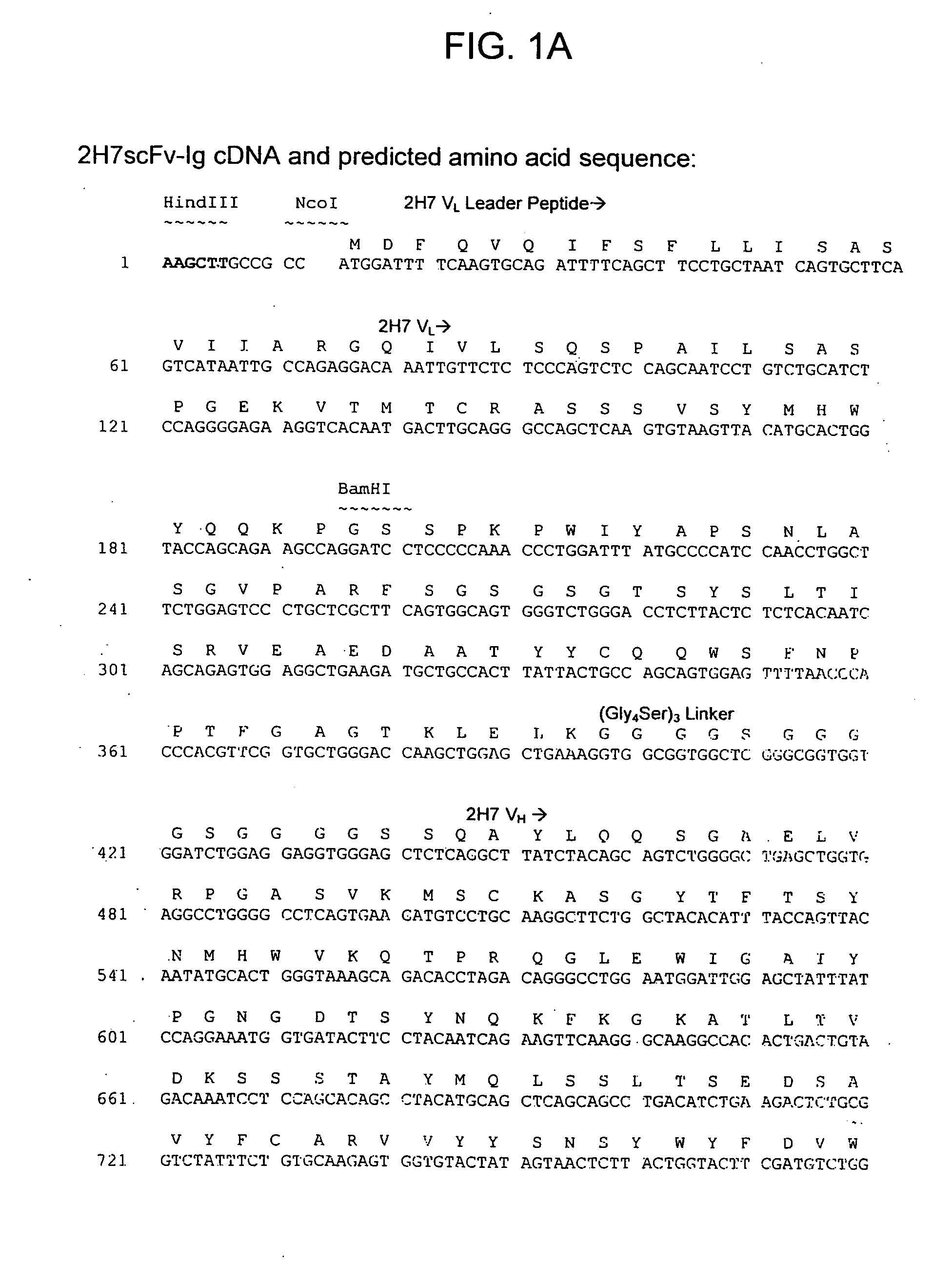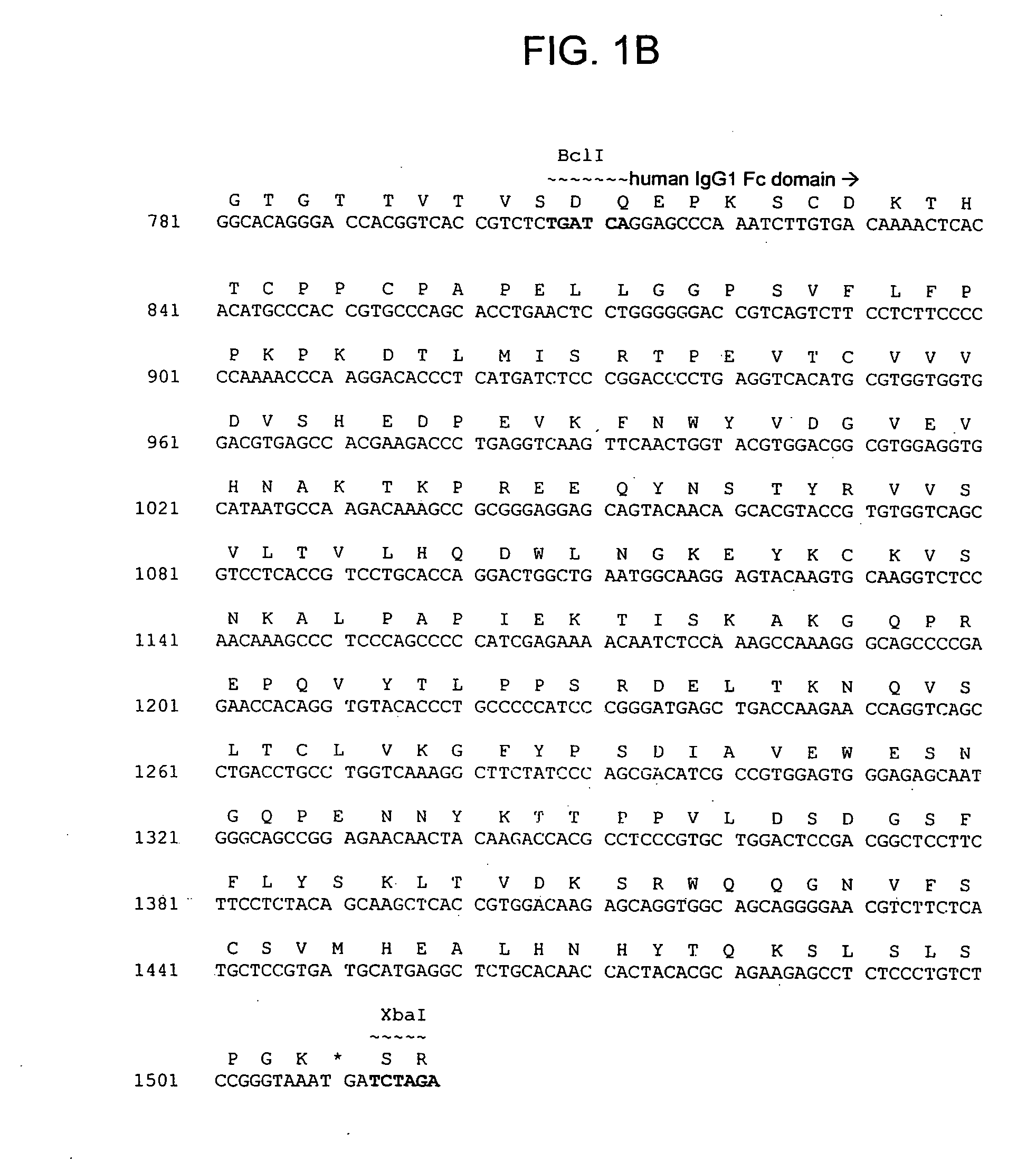Binding domain-immunoglobulin fusion proteins
a technology of immunoglobulin and binding domain, which is applied in the direction of drug compositions, antibody medical ingredients, metabolic disorders, etc., can solve the problems of preventing the delivery of a minimum effective dose to the target tissue, scfv molecules lack stability, and the difficulty in manufacturing adequate amounts of scfv for patients, so as to reduce the ability to dimerize
- Summary
- Abstract
- Description
- Claims
- Application Information
AI Technical Summary
Benefits of technology
Problems solved by technology
Method used
Image
Examples
example 1
Cloning of the 2H7 Variable Regions and Contruction and Sequencing of 2H7scFv-IG
[0165] This Example illustrates the cloning of cDNA molecules that encode the heavy chain and light chain variable regions of the monoclonal antibody 2H7. This Example also demonstrates the construction, sequencing, and expression of 2H7scFv-Ig.
[0166] Hybridoma cells expressing 2H7 monoclonal antibody that specifically bound to CD20 were provided by Ed Clark at the University of Washington, Seattle, Wash. Prior to harvesting, hybridoma cells were kept in log phase growth for several days in RPMI 1640 media (Life Technologies, Gaithersburg, Md.) supplemented with glutamine, pyruvate, DMEM non-essential amino acids, and penicillin-streptomycin. Cells were pelleted by centrifugation from the culture medium, and 2×107 cells were used to prepare RNA. RNA was isolated from the 2H7-producing hybridoma cells using the Pharmingen (San Diego, Calif.) total RNA isolation kit (Catalog # 45520K) according to the ma...
example 2
Expression of 2H7 ScFv-IG in Stable CHO Cell Lines
[0171] This Example illustrates expression of 2H7scFv-Ig in a eukaryotic cell line and characterization of the expressed 2H7scFv-Ig by SDS-PAGE and by functional assays, including ADCC and complement fixation.
[0172] The 2H7scFv-Ig HindIII-XbaI (˜1.6 kb) fragment with correct sequence was inserted into the mammalian expression vector pD18, and DNA from positive clones was amplified using QIAGEN plasmid preparation kits (QIAGEN, Valencia, Calif.). The recombinant plasmid DNA (100 μg) was then linearized in a nonessential region by digestion with AscI, purified by phenol extraction, and resuspended in tissue culture media, Excell 302 (Catalog # 14312-79P, JRH Biosciences, Lenexa, Kans.). Cells for transfection, CHO DG44 cells, were kept in logarithmic growth, and 107 cells harvested for each transfection reaction. Linearized DNA was added to the CHO cells in a total volume of 0.8 ml for electroporation.
[0173] Stable production of the...
example 3
Effect of Simultaneous Ligation of CD20 and CD40 on Growth of Normal B Cells,
and on CD95 Expression, and Induction of Apoptosis
[0180] This example illustrates the effect of cross-linking of CD20 and CD40 expressed on the cell surface on cell proliferation.
[0181] Dense resting B cells were isolated from human tonsil by a Percoll step gradient and T cells were removed by E-rosetting. Proliferation of resting, dense tonsillar B cells was measured by uptake of 3[H]-thymidine during the last 12 hours of a 4-day experiment. Proliferation was measured in quadruplicate cultures with means and standard deviations as shown. Murine anti-human CD20 mAb IF5 (anti-CD20) was used alone or was cross-linked with anti-murine κ mAb 187.1 (anti-CD20XL). CD40 activation was accomplished using soluble human CD154 fused with murine CD8 (CD154) (Hollenbaugh et al., EMBO J. 11: 4212-21 (1992)), and CD40 cross-linking was accomplished using anti-murine CD8 mAb 53-6 (CD154XL). This procedure allowed simult...
PUM
| Property | Measurement | Unit |
|---|---|---|
| temperature | aaaaa | aaaaa |
| total volume | aaaaa | aaaaa |
| total volume | aaaaa | aaaaa |
Abstract
Description
Claims
Application Information
 Login to View More
Login to View More - R&D
- Intellectual Property
- Life Sciences
- Materials
- Tech Scout
- Unparalleled Data Quality
- Higher Quality Content
- 60% Fewer Hallucinations
Browse by: Latest US Patents, China's latest patents, Technical Efficacy Thesaurus, Application Domain, Technology Topic, Popular Technical Reports.
© 2025 PatSnap. All rights reserved.Legal|Privacy policy|Modern Slavery Act Transparency Statement|Sitemap|About US| Contact US: help@patsnap.com



